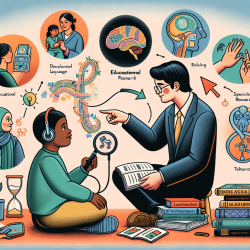Introduction
In the realm of neurological disorders, reversible splenial lesion syndrome (RESLES) stands out due to its rarity and the complexity of its presentation. The recent research article titled "Vertigo and Cytotoxic Lesions of the Corpus Callosum: Report with Review of the Literature" provides valuable insights into this condition, highlighting a unique case that challenges our understanding of RESLES. This blog aims to explore these findings and discuss how they can inform therapeutic practices, particularly in pediatric speech-language pathology.
Understanding RESLES
RESLES is a subset of Posterior Reversible Encephalopathy Syndrome (PRES) characterized by radiographic findings of hyperintensity in the splenium of the corpus callosum. Symptoms often include altered states of consciousness, delirium, and seizures. However, the case presented in the research article involves an atypical presentation of RESLES with isolated vertigo, expanding the clinical spectrum of this condition.
Case Highlights
The case involves a 72-year-old female who experienced isolated vertigo episodes, initially attributed to a possible stroke. However, MRI findings revealed hyperintensity in the splenium of the corpus callosum, consistent with RESLES. Notably, the patient lacked typical risk factors for RESLES, such as infections or metabolic disturbances. Instead, a vitamin B12 deficiency was identified, suggesting a potential link between this deficiency and the radiographic findings.
Implications for Practice
For practitioners in speech-language pathology, particularly those working with children, understanding the diverse presentations of RESLES is crucial. Here are some key takeaways from the research:
- Diverse Symptomatology: RESLES can present with symptoms beyond the typical altered consciousness and seizures, such as vertigo. This highlights the need for comprehensive assessments in cases of unexplained neurological symptoms.
- Role of Vitamin B12: The potential link between vitamin B12 deficiency and RESLES underscores the importance of nutritional assessments in managing neurological disorders. Ensuring adequate vitamin B12 levels could be a simple yet effective intervention.
- Radiographic Monitoring: Regular MRI scans are essential for monitoring the progression or resolution of RESLES lesions, especially in atypical cases.
Encouraging Further Research
This case highlights the need for further research into the underlying mechanisms of RESLES and its diverse presentations. Understanding the role of nutritional deficiencies and other atypical factors can enhance diagnostic accuracy and treatment outcomes.
Conclusion
As practitioners, staying informed about the latest research is vital for improving therapeutic outcomes. The insights from this case of RESLES encourage a broader consideration of symptoms and potential underlying causes, such as vitamin B12 deficiency. By integrating these findings into practice, we can better support children with complex neurological presentations.
To read the original research paper, please follow this link: Vertigo and Cytotoxic Lesions of the Corpus Callosum: Report with Review of the Literature.










